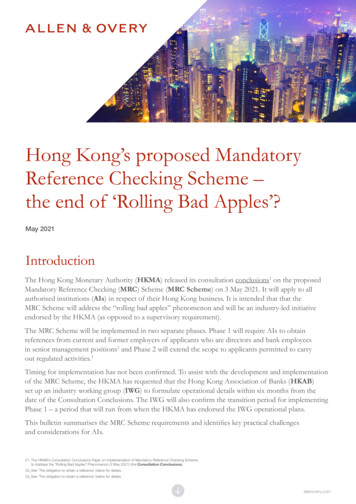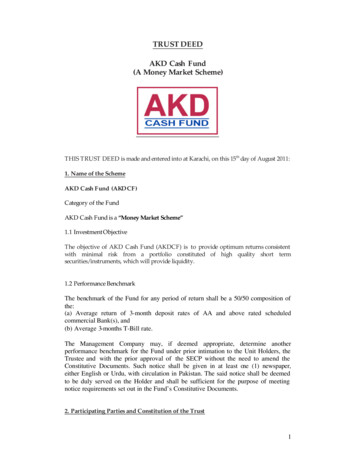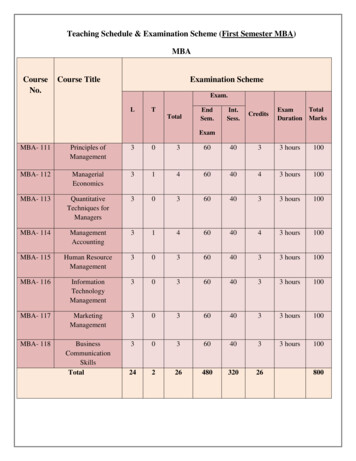
Transcription
Teaching Schedule & Examination Scheme (First Semester MBA)MBACourseNo.Course TitleExamination ionTotalMarksExamMBA- 111Principles ofManagement303604033 hours100MBA- 112ManagerialEconomics314604043 hours100MBA- 113QuantitativeTechniques forManagers303604033 hours100MBA- 114ManagementAccounting314604043 hours100MBA- 115Human ResourceManagement303604033 hours100MBA- 116InformationTechnologyManagement303604033 hours100MBA- 117MarketingManagement303604033 hours100MBA- 118BusinessCommunicationSkillsTotal303604033 hours1002422648032026800
NATIONAL INSTITUTE OF TECHNOLOGY, HAMIRPURTeaching Schedule & Examination Scheme (Second Semester MBA)MBACourseNo.Course TitleExamination DurationTotalMarksMBA- 121BusinessEnvironment3003604033 hours100MBA- 122EntrepreneurshipDevelopment3003604033 hours100MBA- 123Business Law3003604033 hours100MBA- 124OrganizationalBehavior3003604033 hours100MBA- 125FinancialManagement3104604043 hours100MBA- 126ResearchMethodology3003604033 hours100MBA- 127Production &OperationsManagement3003604033 Hours100MBA- 128ProfessionalEthics & HumanValues2002302022 hours5023102445030024TotalThe students are required to go for Industrial Training/ Internship for the period of six weeks after second semesterduring summer break.750
NATIONAL INSTITUTE OF TECHNOLOGY, HAMIRPURTeaching Schedule & Examination Scheme (Third Semester MBA)MBACourseNo.Course TitleExamination 3 hours100MBA-212ConsumerBehavior303604033 hours100Specialization:Any two from(HRM/Marketing/Finance/Operations Management)3X5 1501560 X 5 30040 X 5 200153 hours(Each)100 X 5 50000025*252-502102144530523(Any FiveElectives (3 2)from bothspecializations)MBA-213Industrial TrainingVivaTotal* To be awarded by the organization in which the student will undergo the training750
NATIONAL INSTITUTE OF TECHNOLOGY, HAMIRPURTeaching Schedule & Examination Scheme (Fourth Semester MBA)MBAExamination SchemeS. No.Course No. & 604033 hours100MBA222Major Project000040603-100Specialization: Anytwo 5 15003X5 1560 X 5 30040 X5 2003X5 153 hours(Each)50018001840030021(Any Five Electives(2 3) from bothspecializations)Total700
NATIONAL INSTITUTE OF TECHNOLOGY, HAMIRPURMBAAnnexure 2Courses offered Under SpecializationsSpecialization 1: Human Resource ManagementList of Electives:1.2.3.4.5.6.7.8.Personality Development & Leadership (MBA-HR1)Industrial Relations & Labor Laws (MBA-HR2)Performance and Compensation Management (MBA-HR3)Training Development & Professional Growth (MBA-HR4)Organizational Change & Development (MBA-HR5)Negotiation & Counseling (MBA-HR6)Strategic HRM (MBA-HR7)Human Resource Development (MBA-HR8)Specialization 2: MarketingList of Electives:1.2.3.4.5.6.7.8.Product & Brand Management (MBA-MK1)Advertising Management (MBA-MK2)Sales and Distribution Management (MBA-MK3)International Marketing (MBA-MK4)E- Commerce (MBA-MK5)Marketing Research (MBA-MK6)Services Marketing (MBA-MK7)Retail Management (MBA-MK8)
Specialization 3: FinanceList of Electives:1.2.3.4.5.6.7.8.Security Analysis & Portfolio Management (MBA-FM1)Financial Institutions & Services (MBA-FM2)Behavioral Finance (MBA-FM3)Projects and Infrastructure Management: Financing, Implementation and Control (MBAFM4)Fixed Income Security (MBA-FM5)International Financial Management (MBA-FM6)Corporate Structuring and Valuation (MBA-FM7)Treasury & Risk Management (MBA-FM8)Specialization 4: Operations ManagementList of Electives:1. Inventory Management and Material Planning (MBA-OM1)2. Operations Strategy (MBA-OM2)3. Project Management (MBA-OM3)4. Supply Chain Analytics (MBA-OM4)5. Supply Chain Management (MBA-OM5)6. Logistics Management (MBA-OM6)7. Productivity Management (MBA-OM7)8. Services Operations Management (MBA-OM8)9. Six Sigma & Lean Manufacturing (MBA-OM9)10. Total Quality Management(MBA-OM10)
SyllabusMBASemester – 1stCourses
Principles of Management(MBA – 111)Unit-I:Basics of Management, Classification, Characteristics, and Objectives of management,management and society, Development of Management Thought, Nature and Functions ofManagement, Management by Objectives, managerial skills, roles & functions, manager andbusiness environment.Unit-II:The Nature and Purpose of Planning, Objectives, Strategies, Policies, and Planning premises,Importance of Planning, Concept and Techniques of Forecasting, Strategic and TacticalDecisions, Decision Making Process, Rationality and Creativity in Decision Making.Unit-III:Organizing & staffing- Meaning of organization, types of organization, Organizationstructure, Span of management, Line and staff relationship, Departmentation, DelegationCentralization and decentralization of authority, Meaning of staffing, Recruitment, selection& placement, Training & developmentUnit-IV:Directing & Controlling- Principle of directing, Essence of coordination, Production Planningand Control, Techniques for Operations Planning, Gantt Charts, Program Evaluation andReview Technique, Critical Path Method, Difference between PERT and CPM, Managementby exception.Unit-V:Managing Change & Stress: Concept of change, change as a natural process, Importance &Causes of change – social, economic, and technological, organizational learning –unlearning, concept of learning organizations. Stress management: Definition, Causes,Managing stress, Stress as a motivator. Work life balance.Suggested Readings:1. Koontz Harold & Weihrich Heinz – Essentials of management (Tata Mc Graw Hill, 5thEdition ,2008)2. Robbins & Coulter - Management (Prentice Hall of India, 9th Edition)3. Robbins S.P. and Decenzo David A. - Fundamentals of Management: Essential Conceptsand Applications Pearson Education, 6th Edition.
Managerial Economics(MBA – 112)Unit-I:Introduction to Managerial Economics: Nature and Scope of Managerial Economics,Relationship with other areas in Economics, Production Management, Marketing, Financeand Personnel, Operations research - The role of managerial economist. Objectives of thefirm: Managerial theories of firm, Behavioral theories of firm, Optimization techniques,Optimization with calculus, New management tools of optimizationUnit-II:Demand Analysis, Elasticity of demand, types and significance of Elasticity ofDemand. Demand estimation – Marketing research approaches to demand estimation. Needfor forecasting, forecasting techniques. Supply Analysis – Supply function, the Law ofSupply, Elasticity of Supply.Unit-III:Production function, Marginal Rate of Technical Substitution, Isoquants and Isocosts,Production function with one/two variables, Cobb-Douglas Production Function, returns toScale and Returns to Factors, Economies of scale- Innovations and global competitiveness.Cost theory and estimation: Cost concepts, determinants of cost, cost-output relationship inthe short run and long run, short run vs. long run costs, average cost curves,overall cost Leadership-Break Even Analysis.Unit-IV:FeaturesandTypesofdifferent rfectCompetition, Monopoly, Monopolistic competition andOligopoly both the long run and short run.Suggested Readings:1.2.3.4.Salvatore, Dominick (2012): Managerial Economics, Oxford University Press.Dean, Jod: Managerial Economics, New Delhi, Prentice Hall.Truett, C. J. and D. B. Truett (1984): Managerial economics,2nd ed.,Cincinati, SouthWestern Publication.Ahuja, H.L. (2007): Managerial Economics, S.Chand and Com pvt ltd.
Quantitative Techniques for Managers(MBA – 113)Unit-I:Scope, functions and limitations of statistics, Measures of Central tendency – Mean,Median, Mode, Percentiles, Quartiles, Measures of Dispersion – Range, Interquartile range,Mean deviation, Mean Absolute deviation, Standard deviation, Variance, Coefficient ofVariation. Measures of shape and relative location; Skewness and Kurtosis; Chebyshev'sTheorem.Unit-II:Probability: Theory of Probability, Addition and Multiplication Law, Bayes’ TheoremProbability Theoretical Distributions: Concept and application of Binomial; Poisson andNormal distributions.Unit-III:Time series analysis, Correlation Analysis: Rank Method & Karl Pearson's Coefficient ofCorrelation and Properties of Correlation. Regression Analysis: Fitting of a Regression Lineand Interpretation of Results, Properties of Regression Coefficients and Relationshipbetween Regression and Correlation.Unit-IV:Data analysis: Univariate Analysis; Non-Parametric and Parametric tests, Multivariateanalysis; EFA, Multiple Regression, Discriminant analysis, Conjoint Analysis and Clusteranalysis.Suggested Readings:1. Levin and Rubin – statistics for Management, 7th ed., Pearson2. Lind, Marchal, Wathen – Statistical techniques in business and economics, 13th ed,McGrawHill3. Beri- Statistics for Management (Tata McGraw-Hill)4. Sharma J K - Business Statistics (Pearson Education)
Management Accounting(MBA – 114)Unit-I:Theoretical Framework (meaning, scope and usefulness of Accounting and itsclassification), Generally Accepted Accounting Principles, Concepts and Conventions,Valuation and Accounting estimates, Systems of Book Keeping, Systems of Accounting,Journalising Transactions, Rules of Debit and Credit, Compound Journal Entry, Openingentry.Unit-II:Ledger, Posting, Relationship between Journal and Ledger, Rules regarding posting, TrialBalance- objects and methods of preparing a Trial balance, Voucher System, Subdivision ofJournal, Special Journal, General Journal, Negotiable Instruments, Promissory Note, Bills ofExchange, Cheque.Unit-III:Final Accounts, Trading Account, Profit and Loss Account, Manufacturing Account,Balance Sheet, Pro Forma of Balance Sheet, Adjustment entries, Rectification of Errors,Location of Errors, Rectifying Accounting Entries, Depreciation Provisions and Reserves,Concept of Depreciation, Causes, Features, Meaning and Methods of Depreciation.Unit-IV:Financial Statements: Meaning, Types, Nature and Limitations of Financial Statements,Analysis and Interpretation of Financial Statements, Steps Involved in Financial StatementsAnalysis, Ratio Analysis, Classification of Ratios, Fund Flow Statement, Preparation ofFund Flow Statement, Cash Flow Statement, Utility and Limitations.Unit-V:Basic cost Concepts, Inventory Valuation, Budgerary control – meaning, need, objectives,types; Standard costing and variance analysis (Materials, labour); marginal costing and itsapplication in managerial decision makingSuggested Readings:1. Maheshwari, S.N. and Maheshwari, S.K., Accounting for Management, New Delhi, VikasPublishing House.2. Khan, M.Y. and Jain, P.K., Management Accounting, TMH, New Delhi.3. Singhal, A.K. and Ghosh Roy, H.J., Accounting for Managers, JBC Publishers andDistributors, New Delhi4. Pandey, I.M., Management Accounting, Vikas Publishing House, NewDelhi5. Jain, S.P and Narang, K.L., Advanced Cost Accounting, Kalyani Publishers, Ludhiana.
Human Resources Management(MBA – 115)Unit-I:Nature of personnel management: and its evolution into HRM; historical context in Indiaand abroad, understanding the nature & scope of HRM, context of HRM, integrating HRstrategy with business strategy.Unit-II:Human resources planning: nature, importance of HRP. Factors affecting HRP, the process,barriers, human resources information systems (HRIS), HR accounting and audit, analysis ofwork, designing jobs and analysis; job analysis, its process & methods, job design,recruiting talent; nature, purpose & importance of recruitment, factors governingrecruitment, process, evaluation & control, philosophies of recruitment, selecting righttalent; nature, process, methods, barriers & evaluation.Unit-III:Training and development: orientation its evaluation and problems, training & development;nature of T&D, inputs to T&D, training process, making training effective, managementdevelopment, career development, talent management, appraising & managing performance;nature, process, methods, challenges & legal issues, employee engagement &empowerment, job evaluation, purposes and methods.Unit-IV:Compensation Management; its philosophy, components, theories, importance, factorsaffecting compensation policy, compensation plans and business strategy, compensationplans, challenges, concept of wages, incentives & performance-based pay; types of schemes,group incentives, managing other employee benefits & services; why are they required,types its administration, compensating top management.Unit-V:Organizational culture, providing safe & healthy environment, employee welfare, managingseparations; Termination of employment: retirement, resignation, and termination ofcontract: layoff and exit interviews Dealing with the human aspects of terminations:procedures for terminations, counseling, training and notice of dismissalSuggested Readings:1. Aswathappa- Human Resource Management (Tata McGraw-Hill) – HR and PM, 2003, 3rded.2. Rao V. S. P. – Human Resource Management (Vikas Publication)3. Dessler- Human Resource Management (Prentice-Hall, 9th edition)
Information Technology Management(MBA – 116)Unit-I:Introduction to computers, Advantages, Disadvantages and Applications of computers,Block diagram and working, Data, Information and decision making, ComputerOrganization; Central Processing Unit, Storage Devices; Primary and secondary storagedevices; RAM and ROM, Hard Disk, Magnetic Tape, Optical devices, Input–Outputdevices, Generations of computer systems and growth of personal computers.Unit-II:Operating System: Functions, types- Multiprogramming, Multiprocessing, Timesharing,Real time, Online and Batch Systems, Booting process, Windows environment basics;Desktop, Common Start menu options. Computer and communication networks, Evolutionof computer networks, LAN, MAN, WAN, Network topologies, Modes of Datacommunication, Internet Basics: ISP, Web server, Web Browser, Domain names, Email,Mail server, search engine, web portal, other internet common terms.Unit-III:Microsoft Word-File Handling; basics and advanced Functions like Mail Merge, Macro.Microsoft Excel- Creation of Spread Sheet Applications Using Worksheets & Work Books.Working with Graphics, Designing Charts, Graphs using Spread Sheets. Introduction toPower point.Unit-IV:Information System Classification: Concept of Data and Information, Management SupportSystem (MSS), Transaction Processing System (TPS), Process Control System (PCS),Enterprise Collaboration System (ECS), Management Information System (MIS), DecisionSupport System (DSS), Executive Information System (EIS). Artificial Intelligence (AI),Applications of Artificial Intelligence: Neural Networks, Fuzzy Logical Control System,Virtual Reality, Expert System (ES).Unit-V:Information Systems for Business: Applications; Enterprise Resource Planning (ERP),Customer Relationship Management (CRM), Security and Ethical Challenges of IT,Business Ethics, Technology Ethics; Cyber Crime and Privacy Issues, Cyber Laws, IT Act2000.Suggested Readings:1.2.3.4.5.Shrivastava-Fundamental of Computer& Information Systems (Wiley Dreamtech)Leon A and Leon M - Introduction to Computers (Vikas, 1st Edition).ITL ESL – Introduction to Information Technology (Pearson, 2nd Edition).Introduction to Computers, Norton P. (TATA McGraw Hill)Leon - Fundamentals of Information Technology, (Vikas)
Marketing Management(MBA – 117)Unit-I:Marketing Concept: Importance, scope & core concepts of marketing; Types of orientations inorganization, Marketing management & its tasks; Philosophies of marketing management;Micro and macro marketing environment; Stages of marketing practice; New marketinghorizons and trends; Concepts and components of marketing mix; Target marketing; Marketsegmentation and positioning; Market targeting.Unit-II:Marketing and customer value; The value chain; holistic marketing orientation and customervalue and value maximization strategies; The Customer: Customer life cycle and stages;Customer acquisition and retention; The Competition: Significance of competition; Factorscontributing to enhanced Inter-Firm rivalry; Stages and forms of competition; Framework forcompetitive analysis; Response to competitionUnit-III:Marketing planning: Market measurement and demand forecasting; Market opportunity;Analyzing consumer and business markets; Product market selection; Approaches tomarketing plan; Marketing research and information systems; Consumer Behaviour: Mythsabout the consumer; Consumer decision making; Influences on buyer behavior;Organizational buying behavior.Unit-IV:The Basic concepts of a product; product mix and product line decisions; branding decisions;new product development process; innovation diffusion process; Product life cycle andstrategies; meaning and significance of price; factors influencing pricing; general pricingapproaches; pricing decisions and strategies.Unit-V:Marketing channels and its functions; designing marketing channel; Integrated marketingcommunication, concepts and elements of promotion mix; Basics of international marketing;Managing sales and distribution function.Suggested Readings:1.2.3.4.5.Kotler, P: Marketing Management, Analysis, Planning and Control, 2007, PrenticeHall of India, New Delhi.Gandhi, J.C.: Marketing: A Managerial Introduction, 2000, Tata McGraw Hill.Kotler, P.: Principles of Marketing, ed. ix, Prentice Hall of India, New Delhi.Stanton, Etzel & Walken: Fundamentals of Marketing, ed. x, McGraw Hill.Jha & Singh: Marketing Management in Indian Perspective.
Business Communication Skills(MBA – 118)Unit-I:Introduction: What is communication; Meaning, Objectives and Importance;Communication Process, Noise, Feedback; Different types of Communication, Verbal andNonverbal, Oral and Written, Formal and Informal; Barriers to Communication, InformationRichness Model by Langel & Draft; Different types of Face to Face Interactions;Characteristics and Conventions of Conversations; Conversational Problem of SecondForeign Language User; Difference between Conversation and other Speech Events;Essentials of Effective Communication; Ethics in Business Communication.Unit-II:Nonverbal Communication: Gestures, Body language, Proxemics, Haptics, Chronemics,Oculesics, Para-linguistics; Listening: Difference between Hearing and Listening,Importance of listening, Effective Listening, Barriers to Listening; Speaking and Listening,commonly used Phrases in Telephone conversations, Reading, Conference Calls, Leaving amessage.Unit-III:Job Application: CV, Resume, and Bio Data, Difference between three, Cover Letter;Preparing for an Interview, Dressing for an interview; Essentials of Group Discussion; OralPresentation: Types: Informative and Persuasive, Designing an effective presentation,Structure, Introduction, Body and Ending of a presentation, Visual Aids; Effective speaking,Podium Panic, Voice Dynamics: Intonations, Rhythm, Continuity of Speech, Rhythm ofSpeech, Pronunciation, Style.Unit-IV:Business Messages: Memo Writing, Circular writing, Office Orders, Report Writing: Typesand Formats, Minutes making, Note Taking, Proposal writing; Communication outside theOrganization: Agenda, Quotations, Tenders, Business Letters, Complaints and Follow-upLetters; Business & Group Meetings: Purpose, Types and Responsibility in BusinessMeetings; Persuasive Message Writing.Suggested Readings:1. Managerial Communication, Strategies and Applications by Geraldine E. Hynes, McGrawHill Education (2010).2. Business Communication by KK Sinha, Galgotia Publishing Company.3. Effective Business Communication by Hilderbrandth and Murphy, Irwin McGraw Hill4. Business Communication by Chaturvedi and Chaturvedi, PearsonPublishing.
SyllabusMBASemester – 2ndCourses
Business Environment(MBA – 121)Unit-I:The concept of Business Environment, significance and nature, Environment Scanning:meaning, nature and scope, the process of environmental scanning, Interaction betweeninternal and external environments, basic philosophies of Capitalism and Socialism withtheir variants, Concepts of Mixed Economy; global business environment, nature and scopeof global business; the forces driving global business, modes of entry into global businessUnit-II:Business Environment: Overview of Political: democracy, totalitarianism, engines ofDemocracy, Socio-cultural, Legal, Technological and Global environment. An introductionto MRTP, FEMA, SEBI Act, Consumer Protection Act; The changing dimensions of theselaws and their impact on business; International economic analysis: inflation,unemployment, debt, balance of payment, balance of trade.Unit-III:Philosophy and strategy of planning in India; Industrial Policy in recent years; Policy withregard to small scale industries; the monetary policy and fiscal policy, Trade Theories andInvestment Environment: Theories of trade patterns, interventionist theories, free-tradetheories and theory of absolute advantage, world trade in goods and services: trends anddevelopments; tariff and non-tariff barriers; Issues in FDI and FII; movements in foreignexchange and interest rates and their impact on trade and investment flows.Unit-IV:Social Responsibility of business enterprises, New Economic Policy, Globalization and thecosts of globalization, EXIM policy, Consumerism, International Economic Institutions andAgreements: WTO, IMF, UNCTAD, Regional Economic Integration, major ILOconventionsSuggested Readings:1. Danoes, John D. and Radebaugh, Lee H., International Business: Environment andOperations,Addison Wesley, Readings.2. Hill, Charles W. L., International Business, McGraw Hill, New York.3. Bennet, Roger, International Business, Financial Times, Pitman Publishing4. Suresh Bedi - Business Environment (Excel Books, 1st Edition)5. Francis Cherunilam – Business Environment, Text and Cases (Himalaya Publishing House,8th Edition)
Entrepreneurship Development(MBA – 122)Unit-I:Fundamental definition and types of entrepreneurship, understanding entrepreneurialenvironment in Indian context, theories of entrepreneurship, Entrepreneurial process,entrepreneurship and technology, incubation centers, innovation and technology transfer,dynamics of technology adoptionUnit-II:Fundamentals of project management, risk assessment, socio-economic dynamics,understanding financial issues of small enterprises, project evaluation and reportpreparation, entrepreneurial challenges and strategies, digital revolution andentrepreneurship developmentUnit-III:Role of higher learning institutions in entrepreneurship development, understanding thesignificance of government schemes like Start-Up India, Stand-Up India and MUDRA etc.in entrepreneurship development, social entrepreneurship, rural entrepreneurship, CaseStudiesUnit-IV:Women Entrepreneurship: Meaning, Characteristic features, Problems of WomenEntrepreneurship in India, Developing Women Entrepreneurship in India, Concept of SocialEnterprise and Social Entrepreneurship, Social Entrepreneurs, Sustainability Issues in SocialEntrepreneurship, Rural Entrepreneurship, Family Business Entrepreneurship, Concepts ofEntrepreneurship Failure, Issues of Entrepreneurial failure, Fading of Entrepreneurialsuccess among once leading corporate groups, Entrepreneurial resurgence, Reasons ofEntrepreneurial Failure, Essentials to Avoid Unsuccessful Entrepreneurship.Unit-V:Forms of Business Ownership, Issues in selecting forms of ownership, EnvironmentalAnalysis, identifying problems and opportunities, Defining Business Idea, PlanningBusiness Process, Project Management; Concept, Features, Classification of projects, Issuesin Project Management, Project Identification, Project Formulation, Project Design andNetwork Analysis, Project Evaluation, Project Appraisal, Project Report Preparation,Specimen of a Project ReportSuggested Readings:1. Forbat, John, “Entrepreneurship” New Age International.2. Hisrich et al., “Entrepreneurship” McGraw Hill3. Journal of Entrepreneurship (Sage Publication)
Business Law(MBA – 123)Unit-I:The Indian Contract Act, 1872: Definition of a Contract and its essentials, Formation of avalid Contract - Offer and Acceptance, Consideration, Capacity to Contract, Free consent,Legality of object, Discharge of a Contract by performance, Impossibility and Frustration,Breach, Damages for breach of a contract, Quasi contracts. Special Contracts Contract ofIndemnity and Guarantee, Contract of Bailment and Pledge, Contract of Agency.Unit-II:The Companies Act, 1956: Nature and Definition of a Company, Registration andIncorporation, Memorandum of Association, Articles of Association, Prospectus, Kinds ofCompanies, Directors: Their powers and duties, Meetings, Winding up. The ConsumerProtection Act, 1986: Aims and Objects of the Act, Redressal Machinery under the Act,Procedure for complaints under the Act, Remedies and Appeals, Enforcement of orders andPenalties.Unit-III:The Sale of Goods Act, 1930: Definition of a Contract of Sale, Conditions and Warranties,Passing of Property, Right of Unpaid Seller against the Goods, Remedies for Breach. TheNegotiable Instrument Act, 1881: Definition and characteristics, Kinds of negotiableinstruments, Promissory Note, Bill of Exchange and Cheques, Holder and Holder in duecourse, Negotiation, Presentment, Discharge from Liability, Noting and Protest,Presumption, Crossing of Cheques, Bouncing of Cheques.Unit-IV:The Indian Partnership Act, 1932: Definition of Partnership and its essentials, Rights andDuties of Partners: Types of Partners, Minor as a partner, Doctrine of Implied Authority,Registration of Firms, Dissolution of firms. Limited Liability Partnership Act, 2000:Incorporation by registration, Relationship of members, members as agents, ex- members,designated members, Cessation of trade by Limited liability partnership, Insolvency andwinding up.Unit-V:The Information Technology Act, 2000; The Right to Information Act, 2005- Salientfeatures, Obligation and Designation of Public Information officer, Duties of a PIO,Exemption and Partial disclosure, Appellate Authorities, Copyright, patent, trademarkSuggested Readings1.2.3.4.N. D. Kapoor & Rajni Abbi - General Laws & Procedures (Sultan Chand & Sons).Kuchhal M.C. - Business Law (Vikas Publication, 4th Edition)Gulshan S.S. - Business Law Including Company Law (Excel Books)Avtar Singh - Principles of Mercantile Law (Eastern Book Company, 7th Edition).
Organizational Behavior(MBA – 124)Unit-I:Organizational Behavior (OB): Concept, nature, characteristics, conceptual foundations,determinants and importance, management functions, roles & skills, disciplines thatcontribute to the field of OB, challenges & Opportunities for OB, diversity in organizations,attitudes & job satisfactionUnit-II:Perception: Concept, nature, process, importance, management and behavioral applicationsof perception. Personality: Concept, nature, types and theories of personality shaping.Learning; Concept and theories of learningUnit-III:Motivation: Concept, principles, theories – content, process & contemporary, Monetary andnon- monetary motivation, applications of motivation. Leadership: Concept, functions,styles, and theories of leadership-trait, behavioral, and situational.Unit-IV:Analysis of Interpersonal Relationship, developing interpersonal relationship, GroupDynamic: Definition of Group, stages of Group Development, Punctuated EquilibriumModel, Group Structure, Group Decision Making, understanding work teams.Unit-V:Organizational power and politics: Concept of power, sources of power, classification ofpower, contrasting leadership & power, dependence a key to power, causes & consequencesof political behavior. Organizational Conflict: views of conflict, conflict process, negotiation& bargaining strategies.Suggested Readings:1. Robbins, S.P., Organizational Behavior, Prentice Hall of India.2. Luthans, F., Organizational Behavior, McGraw-Hill Publishing.3. Davis, K., Human Behavior at Work: Organizational Behavior, Tata McGraw-HillPublishing Co.
Financial Management(MBA – 125)Unit-I:Financial Management: An Overview Finance and Related Disciplines; Scope of FinancialManagement; Objectives of Financial Management; Primary Objective of CorporateManagement; Agency Problem; Organization of Finance Function; and Emerging role ofFinance Managers in India. Time Value of Money: Rationale; Techniques; PracticalApplications of Compounding; and Present Value Techniques. Risk and Return: ConceptualFramework of Risk and Return: Type of Risks; Risk and Return of a Single Asset; Risk andReturn of Portfolio (only two asset portfolio); Portfolio Selection; and Capital Asset PricingModel (CAPM).Unit-II:Capital Budgeting – Principles and Techniques: Nature of Capital Budgeting; DataRequirement; identifying Relevant Cash Flows; Evaluation Techniques; and CapitalBudgeting Practices in India Capital Budgeting – Additional Aspects Net Return Value;Internal Rate of Return; Profitability Index Methods – A Comparison; Project SelectionUnder Capital Rationing; and Inflation and Capital Budgeting. Analysis of Risk andUncertainty in Capital Budgeting Description and Measurement of Risk; and RiskEvaluation Approaches.Unit-III:Concept and Measurement of Cost of Capital: Importance and concept; Measurement ofSpecific Costs; Computation of Overall Cost of Capital; and Cost of Capital Practices inIndia. Operating Leverage; Financial Leverage; and Combined Leverage. Capital StructureCost of Capital and Valuation: Capital Structure Theories; Net Income Approach; NetOperating Income (NOI) Approach; Modigliani-Miller (MM) Approach; and TraditionalApproach. Designing Capital Structure Profitability Aspect; Liquidity Aspect; Control;Leverage Ratios for other Firms in the Industry; Nature of Industry; Consultation andInvestment Bankers and Lenders; Maintaining Maneuverability for
Teaching Schedule & Examination Scheme (Third Semester MBA) MBA Course No. Course Title Examination Scheme L T Total Exam. Credits Exam Duration Total End Marks Sem. Exam Int. Sess. MBA-211 Operations Research 3 0 3 60 40 3 3 hours 100 MBA-212 Consumer Behavior 3 0 3 60 40 3 3 hours 100 Specialization: Any two from (HRM/Marketing/
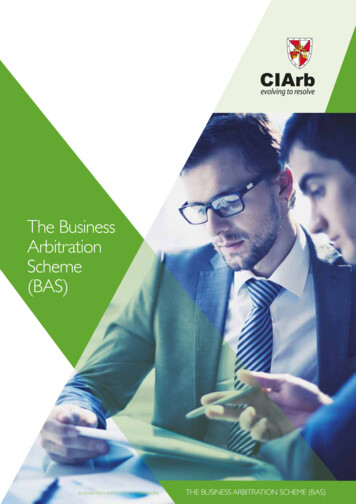
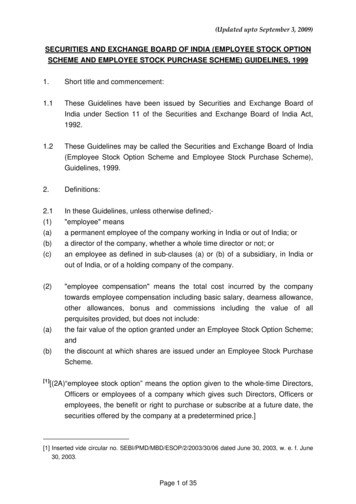
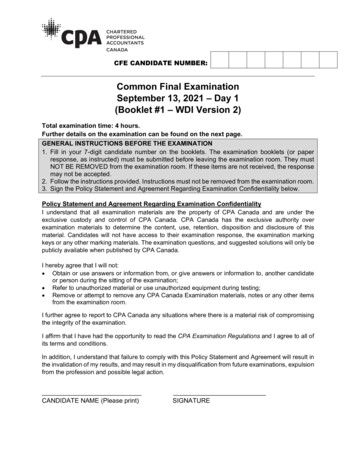
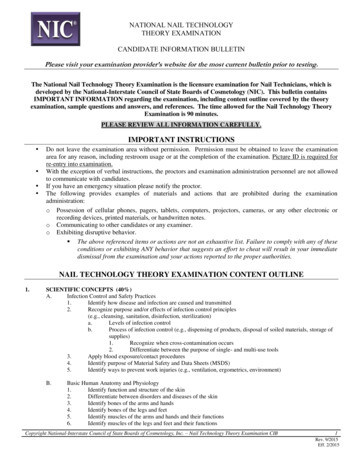
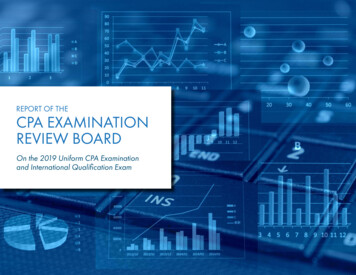
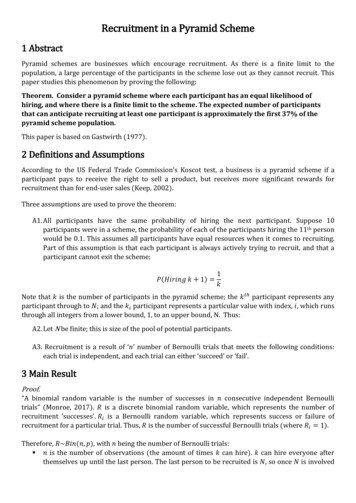
![[Title to come] DSP Dynamic Asset Allocation Fund](/img/24/dsp-dynamic-asset-allocation-fund.jpg)
